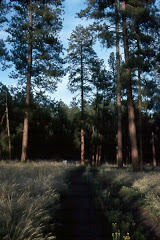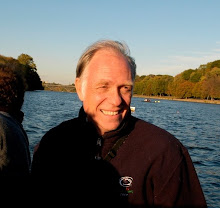Sunday, August 30, 2009
Monday, August 17, 2009
A Weather Glance

The tropics are becoming active as the summer winds down and early fall approaches. Bill, Ana, and Claudette are in the news. From my own front porch I photograph a distant thundercloud to the east and include both my photo and a later NWS radar image of the area in this post.

Fortunately, in terms of severe storms I have never experienced direct hits by either tornadoes or hurricanes. I have come close though. I was in Vickburg, Mississippi helping out in the aftermath of Katrina in 2005 when, for short period of time, a Category 5 Rita was taking aim at Louisiana. I was wondering what I would do as it was taking aim. For a brief instant I considered standing my ground and seeking providential help but only for an instant... Rita turned a bit toward the west and weakened (although there was till major damage). For those who have not seen the destruction from a storm surge, or the path of a severe tornado, suffice to say that it is a very humbling experience.
 I have quite a few photographs and maps from my work there, but I will save that for another day. I consider global change, including climate change, to be a critical challenge for humanity. The long and short of it is that we must be as a willow, not breaking, bending in the wind and understanding that there is an ecological language that we must speak, and fluently, to evolve for the future.
I have quite a few photographs and maps from my work there, but I will save that for another day. I consider global change, including climate change, to be a critical challenge for humanity. The long and short of it is that we must be as a willow, not breaking, bending in the wind and understanding that there is an ecological language that we must speak, and fluently, to evolve for the future.
Labels:
hurricanes,
storms,
weather events
Sunday, August 9, 2009
Mind Mapping Light

The front porch is a nice spot to settle in to the day. This morning's light was especially comfortable on this August 9th, 2009 (see photograph). The Sabbath. A day to contemplate and sense what is around you. The geese rise to the air in the distance honking all the way and filling our valley with their unique sound. I watched as they communicated their timeless act of gathering into the air. Further off though in our very human lens on the world there are stories and photographs of challenge and tragedies across the world. A Sabbath there too, but in a reflection of biological play of ebbs and flows of time there is the unsettling wonder of it all. Disconcerting in the providential plot of things and how they have been, and of now, and of what they will be.
Yesterday I picked up an old article by Bill Benson that he had written in the computer publication, Byte. This was way back when (1985) and as a consequence of what the author, Jerry Pournelle, had written about the Macintosh at that time. Bill essentially said that visual thinking goes hand in hand with creativity. He cited Albert Einstein and said that Albert thought in images, "...not words or even mathematical symbols Albert aside, there probably is some merit in looking at how we 'interact' with what is around us.

The ability of our children to perceive, or maybe discern, what is around us relates to what each of us teach our children, but especially in how our educational system approaches and implements the act of conveying what each of our teachers know to their students. Probably the art of teaching is a non-linear process albeit knowledge surely is, but there are tools out there that might facilitate this. Again, Bill Benson mentions this in his article, but I especially appreciate mind mapping. I like it because I can take my words and really translate them into images. I could go on about this, but I will leave it there. There are a number of tools out there, for business, but also for teachers. Recommended.

Finally, back to where I started out this post is that looking at the morning light is the start of perceiving what is in that light. And yes, perhaps your chair is not quite so comfortable as my front porch, but my first 18 or so years were spent in and around the city too so I know, you can find greenscapes just about wherever you look no matter where you are. Challenging the world can begin with recognizing that there is a story to tell closer than you think.
Footnote: The best, and I mean the best, computer magazine ever was Byte. Hats off to Tom, Jerry and many others. For those who were fans, and I was one, this publication approached legendary levels. I wish it would return...Ojala.
Labels:
albert einstein,
education,
Mind mapping
Monday, August 3, 2009
Saturday, August 1, 2009
My Favorite Modeller

"Which of the wanderers through these different mazes will step forward at the call for the real Herbert Simon? All of them; for the "real" self is an illusion. We live each hour in context, different contexts for different hours. To say, truly that we are actors does not make us "unreal" or hypocritical. We act our lives within the mazes in which Nature and society place us." (Simon, 1991)
I've played around quite a bit with a concept called "context moment." The essence of it is that it is a unique state that gives birth to emergent phenomena. Which is that we are all really travelers through space and time and therein is the seedbed for something new. My only question is how different is your context moment in terms of, maybe not speed, but of a something (i.e., metric) that represents you. And how can you/we relate/access/share/save your/our corner of the world.
It is interesting that the reason for this little traverse arises from my delving into knowledge management concepts, essentially trying to leverage what each of know, so that our own employers/organizations potentially can tap into the wellspring of baby boomer knowledge for future use (given that most of the baby boomers, including me, will be retiring in the next few years). As it happens I read a couple of articles by Alex and David Bennet pertaining to the "next generation knowledge organization." They have written and are writing quite a bit on the field. Much of which is thought-provoking and characterizes "an environment of rapid change, high complexity and large uncertainty." New technologies play a major role in this mix.
In "Connections: new ways of working in the networked organization," Sproul and Keiesler (1991) discuss a two-level perspective on technology involving efficiency and social systems. Sproul and Kiesler argue that there are second-level effects (as opposed to looking at first-level effects) that correlate with "new uses of technology, new ways of working and living, new skills, and new ways of thinking." The authors suggest that these changes are deviation-amplifying effects. The consequence of these small changes or effects is-akin to the butterfly effect or perhaps tipping point-a new permanent state.
Herbert A. Simon said, "In describing my life. I have situated it in a labyrinth of paths that branch, in a castle of innumerable rooms. The life is in moving through that garden or castle, experiencing surprises along the path you follow, wondering (but not too solemnly) where the other paths would have led; a hueristic search for the solution of an ill-structured problem. If there are goals, they do not so much guide the search as emerge from it. It needs no summing up beyond the living of it."
Herbert is "my favorite modeller." Yet, pending changes, I leave my model behind. This is not so much by choice but as a consequence of where 'we' are. Knowledge, connections and relationships, in virtual space and time, will re-create our world and our place in it-essentially delegating the task of discerning reality.
Related references:
Pierre Teilhard de Chardin
Technological singularity
Labels:
Herbert Simon,
knowledge management
Subscribe to:
Posts (Atom)

